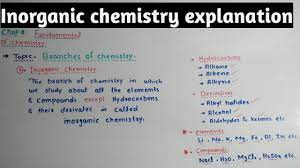What are the main topics in inorganic chemistry?
Related Topics in Inorganic Chemistry

- Organometallic Chemistry.
- Transition Elements.
- Coordination Number.
- P-Block Elements.
- s- Block Elements.
- Acid , Bases and Salts.
- Crystal Field Theory (CFT)
- Valence Bond Theory.

Inorganic chemistry is the study of the properties, structures, and reactions of inorganic compounds and materials. Some of the main topics studied in inorganic chemistry include:
- Periodic Properties of the Elements: Study of the periodic table and the properties of the elements, including their electronic configurations, oxidation states, and reactivity.
- Acid-Base Chemistry: Study of acid-base equilibria and the behavior of acids and bases in solution.
- Coordination Chemistry: Study of metal-ligand complexes and the interactions between metal ions and organic molecules.
- Main-Group Chemistry: Study of the chemistry of elements in the s- and p-blocks of the periodic table, including the chemistry of the alkali and alkaline earth metals, the halogens, and the noble gases.
- Transition Metal Chemistry: Study of the chemistry of elements in the d-block of the periodic table, including the reactivity, coordination chemistry, and spectroscopy of transition metal complexes.
- Solid State Chemistry: Study of the structures, properties, and reactivity of solid materials, including ionic solids, covalent solids, and metals.
- Bioinorganic Chemistry: Study of the role of metals in biological systems, including the structure and function of metalloproteins and metal-containing enzymes.
- Environmental Chemistry: Study of the behavior and impact of inorganic compounds in the environment, including water chemistry, air pollution, and toxicology.
- Materials Chemistry: Study of the design and synthesis of new inorganic materials with specific properties and applications, including catalysts, batteries, and superconductors.
These are some of the main topics studied in inorganic chemistry, but the field is constantly expanding and evolving, with new developments and discoveries being made all the time.
Some main chapters come under Inorganic Chemistry
(a) Organometallic Chemistry
Organometallic Chemistry, an interdisciplinary science in Inorganic Chemistry, has grown at a phenomenal pace during the last three to four decades. On the academic plane, efforts to elucidate the nature of bonds in the ever increasing list of exciting organometallic compounds have led to a clearer understanding of the nature and variety of chemical bonds.
Organometallic compounds are primarily used as homogeneous catalysis agents in industries. The topics covered in this book offer the readers new insights in the field of organometallic chemistry.
Organometallic chemistry is an organometallic compound study. Because many compounds without these bonds are chemically identical, an alternative may be compounds containing metallic bonds of a mostly covalent nature. Organometallic chemistry blends elements of inorganic chemistry with organic chemistry.
(b) Transition Elements
A transition element may be defined as one which possesses partially filled d-orbitals in its penultimate shell. This conceptual definition is useful as it enables us to recognize a transition element merely by looking at its electronic configuration. This definition excludes zinc, cadmium and mercury from the transition elements as they do not have a partially filled d-orbital. However, they are also considered transition elements, because their properties are an extension of the properties of transition elements in inorganic chemistry. In fact, the zinc group serves as a bridge between the transition elements and the representative elements.
The most notable characteristics shared by the 24 elements concerned are that they are all metals and that most of them are hard, solid and lustrous, have high melting and boiling points and are good conductors of heat and electricity. The range in these properties is considerable; hence, the statements are comparable to the general properties of all the other elements.
(c) Coordination Chemistry
Coordination compounds found their applications long before the establishment of inorganic chemistry. A systematic investigation of structure and bonding in coordination chemistry began with the inquisitiveness of Tassaert which was extended by distinguished chemists like Wilhelm Blomstrand, Jorgensen and Alfred Werner until the end of the nineteenth century. In the events, Werner’s coordination theory became the base of modern coordination chemistry.
(d) P-Block Elements
The elements placed in group 13 to group 18 of the periodic table constitute the p-block. The properties of inorganic chemistry p block elements like that of other block elements are greatly influenced by their atomic size, ionization enthalpy, electron gain enthalpy and electronegativity. The absence of d–orbitals in the second period and presence of d- or f-orbitals in heavier elements has a significant effect on the properties of the elements and therefore, heavier p-block elements differ from their lighter congeners.
Join EXPRTO for personal mentorship